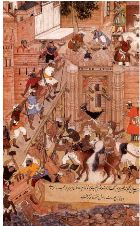Rulers and Buildings - Worksheets
CBSE Worksheet 01
Rulers and Buildings
- Identify the following figure:-

- Painting from the Jahangir Nama
- Painting from the Humayun Nama
- Painting from the Babar Nama
- Painting from the Akbar Nama
- Sultan Mahmud of Ghazni looted which temple
- Lotus
- Somnath
- Birla
- Vithal
- The Rajarajeshvara temple is located in:
- Durg
- Thanjavur
- Madurai
- Vrindavan
- Tomb of Humayun, constructed between
- 1568 and 1581
- 1564 and 1578
- 1562 and 1571
- 1566 and 1578
- An inscription in the Delhi mosque explained that God chose Alauddin as a king because he had the qualities of
- Moses and Shiva
- Shiva and Vishnu
- Moses and Solomon
- Vishnu and Solomon
Match the following:
(a) Eight paradise (i) king’s reservoir (b) Bhairava (ii) Qutub-ud-din Aibak (c) Quwwat-ul-Islam(e) mosque (iii) A form of Shiva (d) Hauz-i-Sultani is also known as (iv) Hasht behest - Fill in the blanks:
The ________ temple at Thanjavur had the tallest shikhara amongst the temples of its time.
- State true or false:
Persian court chronicles described the Sultan as the Shadow of God.
Name the temple built by king Rajarajadeva.
Where was Shah Jahan's capital in the early years of his reign?
What type of structures were built by kings and their officers between the eighth and the eighteenth centuries?
What kind of structures were constructed by kings and their officers between the 8th and the 18th centuries?
Describe the style of architecture in South India.
CBSE Worksheet 01
Rulers and Buildings
Solution
- (d) Painting from the Akbar Nama Explanation: The given figure is a painting from the Akbar Nama (dated 1590-1595), showing the construction of the water-gate at the Agra Fort.
- (b) Somnath Explanation: Sultan Mahmud was not a very important ruler at that time. But by destroying and looting temples – especially the one at Somnath – he tried to win credit as a great hero of Islam.
- (b) Thanjavur Explanation: The Rajarajeshvara temple at Thanjavur had the tallest shikhara amongst temples of its time
- (c) 1562 and 1571 Explanation: The construction of Humayun's tomb was started 1562 and took nine years to complete i.e 1571.
- (c) Moses and Solomon Explanation: An inscription in the Delhi mosque explained that God chose Alauddin as a king because he had the qualities of Moses and Solomon, the great law-givers of the past.
(a) - (iv), (b) - (iii), (c) - (ii), (d) - (i)
- Rajarajeshvara
- True
The Rajarajeshvara temple was built in the early 11th century at Thanjavur.
- It was at Agra.
During this period kings and their officers built two kinds of structures.
- Forts, palaces, garden residences and tombs
- Structures meant for public activity including temples, mosques, tanks, wells, caravanserais and bazaars.
Between 8th and the 18th centuries the kings and their officers built following two kinds of structures
- There were forts, palaces, gardens, residences, and tombs which were safe, protected places of rest in this world and the text.
- Structures meant for public activity including temples, mosques, tanks, wells, caravan, serais, and bazaars were also built.
- In South India, the Pandyas, the Pallavas and the Cholas were great temple builders.
- The South Indians follow the Dravidian style of architecture.
- The gateway of the temple was known as Gopuram.
- The area where the image of Gods and Goddesses was kept was called Garbhagriha.
- The mandapa was located in front of the Garbhagriha. It was an assembly hall where people gathered for prayers.
- The top of the main shrine had a tower-like structure called the Shikhara.
- The famous temples built under Cholas were the Brihadeeswara temple and the Gangaikondacholapuram temple.
